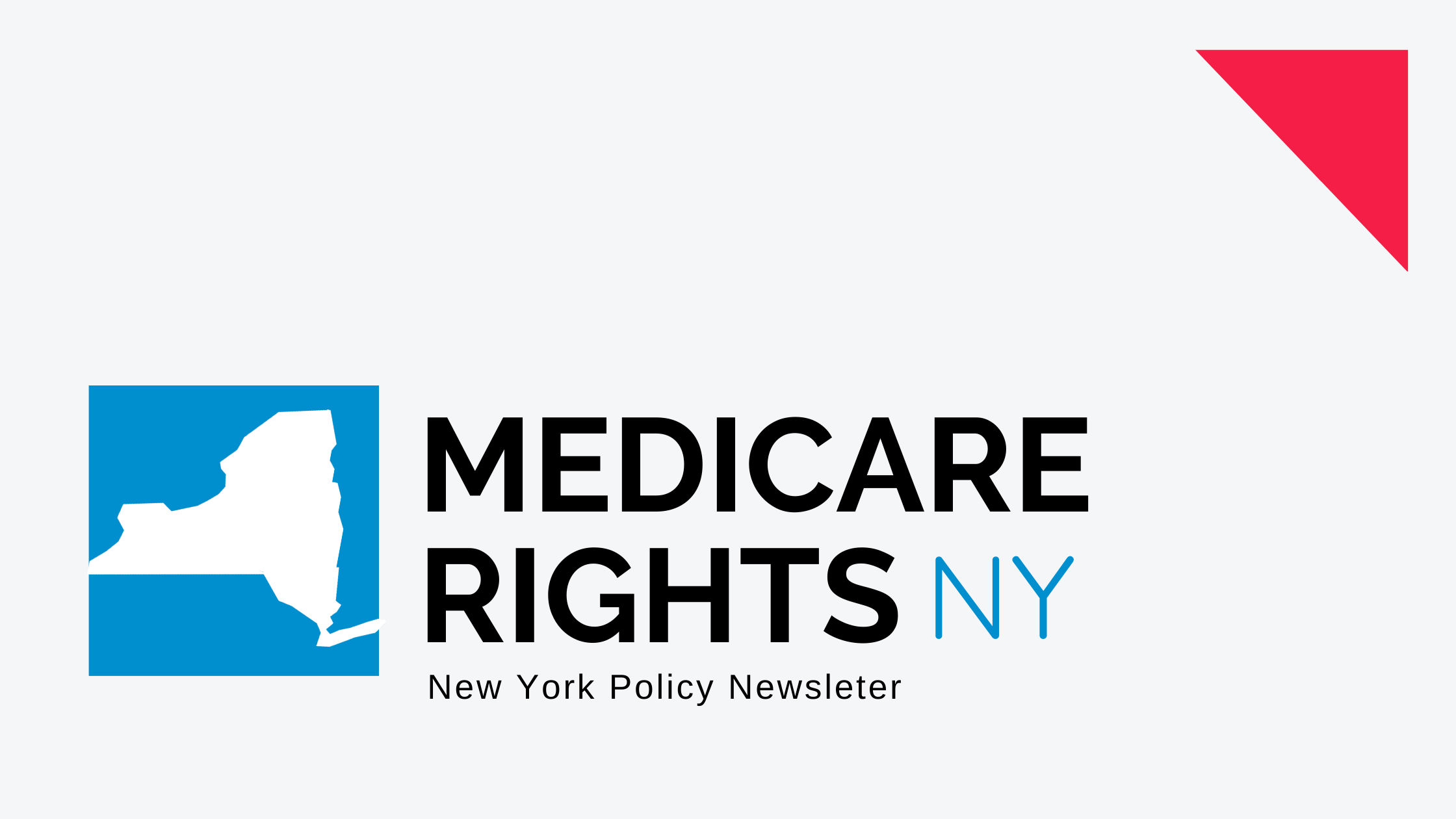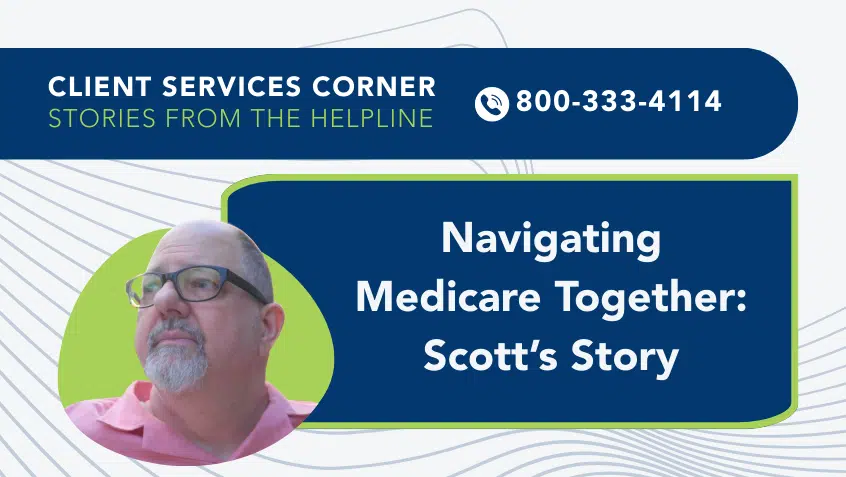Join Us Live for a Discussion on Medicare, Democracy, and the Future of Health Care

Medicare Rights Advocacy
Medicare Rights works with the Center for Medicare & Medicaid Services (CMS) to continue to improve Medicare Plan Finder
Medicare Rights remains concerned that the Medicare Plan Finder redesign may further complicate the plan comparison process for some beneficiaries. Specifically, issues with the new tool’s roll-out, content, and functionality could cause beneficiaries to make sub-optimal coverage decisions and errors they may not discover until well into the next year.
To mitigate these potential hardships and continuously improve Medicare Plan Finder, Medicare Rights is working with CMS and other stakeholders to address problems with the tool. Medicare Rights applauds the agency’s responsiveness in quickly adopting recommendations, but urges CMS to take steps to prevent beneficiaries from experiencing any Plan Finder-related enrollment complications in 2020.
Medicare Rights looks forward to continuing to work with CMS to ensure that older adults and people with disabilities have the tools and resources they need to make informed coverage decisions.
Toolkit provides information about Medicare coverage options for dually eligible beneficiaries in New York
Medicare Rights has updated a resource on the various coverage options available for New York beneficiaries eligible for both Medicare and Medicaid (dual-eligibles). Updates include a new resource on integrated appeals for Medicaid Advantage Plus (MAP) enrollees and an FAQ on coverage options for dually-eligible New Yorkers.
This toolkit will roll out in 2019-20, with covered topics including:
- Transitions for beneficiaries currently enrolled in New York’s Fully Integrated Duals Advantage program, which is ending December 31, 2019
- Dual-eligible Special Needs Plans (D-SNPs) and Medicaid Advantage
- Options for beneficiaries who need long-term care, such as MAP and the Program of All-Inclusive Care for the Elderly (PACE)
- Decision-making for special populations
To view the toolkit, visit Medicare Interactive. Planning for and development of this toolkit are made possible with support from the Altman Foundation, the Fan Fox and Leslie R. Samuels Foundation, and the van Ameringen Foundation.
New York State and Federal Government Updates
Medicare costs in 2020
Recently, CMS announced the standard Medicare Part A, Part B, and Part D costs for 2020. These costs include the Part B premium, Original Medicare cost-sharing amounts, and the Income-Related Monthly Adjustment Amount (IRMAA) for Parts B and D. To review these figures, visit Medicare Interactive.
Among other figures, CMS announced that the Part B premium will increase from $135.50 to $144.60 per month in 2020. This increase comes on the heels of the recently announced cost-of-living adjustment (COLA) for 2020. Next year individuals will see an increase of 1.6% in their Social Security benefits – an average of about $24 per month.
For more information about COLA in 2020, please visit Medicare Rights’ blog.
Medicare Advantage supplemental benefits in 2020
Beginning in 2020, due to the Balanced Budget Act (BBA) as implemented in the 2020 Call Letter, Medicare Advantage (MA) Plans can offer supplemental benefits to individuals with chronic conditions. These are known as Special Supplemental Benefits for the Chronically Ill (SSBCIs). SSBCIs aim to improve health outcomes for those with chronic conditions, and they do not have to be primarily health-related. An MA Plan may provide a benefit to an enrollee with a chronic illness if the benefit has a reasonable expectation of improving or maintaining health or function.
Examples of SSBCIs include:
- Meal delivery, food, and produce
- Transportation for non-medical needs
- Pest control
- Equipment to improve indoor air quality, such as air conditioner, dehumidifiers, and carpet cleaning
- Social needs benefits, such as park passes and family counseling
MA Plans can tailor SSBCIs to plan enrollees with only certain chronic conditions, which means that a benefit may not be available for all enrollees with chronic conditions. For example, a plan may cover pest control only for plan enrollees with severe asthma. If a plan enrollee does not have severe asthma, even if they have mild asthma, then they may not be able to get the plan to cover pest control.
For more information on Medicare Advantage supplemental benefits, please visit Medicare Rights’ blog.
Medicare coverage of opioid treatment programs
Starting January 1, 2020, Medicare Part B covers opioid use disorder (OUD) treatment received at opioid treatment programs (OTPs). This is a result of the passage of the SUPPORT Act and changes to the 2020 Physician Fee Schedule. The expanded Medicare coverage is intended to help address the opioid epidemic by providing beneficiaries with access to more services.
OTPs, which are also known as methadone clinics, are certified by the Substance Abuse and Mental Health Services Administrations (SAMHSA) to provide methadone as part of medication-assisted treatment (MAT). OTPs are the only places where an individual can receive methadone to treat opioid use disorder (methadone prescribed for pain relief does not have to be provided by an OTP). Before 2020, Medicare did not cover OTPs, which meant that beneficiaries could not get Medicare coverage for any care they received at an OTP, including methadone treatment.
For more information on Medicare OTP coverage, please visit Medicare Rights’ blog.
Equitable relief for Marketplace enrollees reminder
Recently, CMS expanded the equitable relief for Marketplace enrollees (previously known as time-limited equitable relief) opportunity to people who are enrolled in Marketplace plans but could have enrolled in Medicare Part B during their SEP, which was available to them after they lost their, a spouse’s, or a family member’s job-based insurance. This opportunity is now available to beneficiaries through June 30, 2020.
CMS also announced plans to increase communication efforts to Medicare-eligible individuals about the risks of delayed Part B enrollment. For more information on these efforts, please visit Medicare Rights’ blog.
For more information on equitable relief for Marketplace enrollees and how to apply, visit Medicare Rights’ online resource, Medicare Interactive.
Client Story
Utilizing equitable relief for Marketplace enrollees
Mrs. Q had coverage through the Marketplace before becoming Medicare eligible. She declined Part B to keep Marketplace coverage after receiving misinformation. Mrs. Q called Medicare Rights’ national helpline after being told that she could no longer have a Marketplace plan, and that she would have to wait until the General Enrollment Period (GEP) to enroll in Part B. Using the GEP would mean that Mrs. Q’s coverage would not start until July and she would incur a premium penalty.
A Medicare Rights helpline counselor was able to identify her as eligible for equitable relief for Marketplace enrollees and provide her with resources to request that Social Security waive her late enrollment penalty.
Register for Medicare Rights NY
Medicare Rights NY is a regular email newsletter with updates on health policy and advocacy developments in New York State and their impact on older adults and people with disabilities. Stay up-to-date on key policy developments that affect older New Yorkers and those with disabilities.
Show Comments
We welcome thoughtful, respectful discussion on our website. To maintain a safe and constructive environment, comments that include profanity or violent, threatening language will be hidden. We may ban commentors who repeatedly cross these guidelines.
Help Us Protect & Strengthen Medicare
Donate today and make a lasting impact
More than 67 million people rely on Medicare—but many still face barriers to the care they need. With your support, we provide free, unbiased help to people navigating Medicare and work across the country with federal and state advocates to protect Medicare’s future and address the needs of those it serves.
The Latest
Most Read
Add Medicare to Your Inbox
Sign up to receive Medicare news, policy developments, and other useful updates from the Medicare Rights.
View this profile on InstagramMedicare Rights Center (@medicarerights) • Instagram photos and videos









